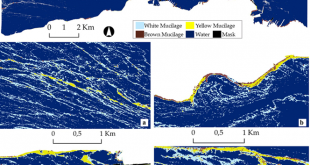Ecological Indicators, 74, 384–391, (2017)
Monitoring Soil Salinity via Remote Sensing Technology Under Data Scarce Conditions: A Case Study From Turkey
Gorji, T., Sertel, E., Tanik, A.
Abstract: Soil salinization is one of the severe land-degradation problems due to its adverse effects on land productivity. Each year several
hectares of lands are degraded due to primary or secondary soil salinization, and as a result, it is becoming a major economic and
environmental concern in different countries. Spatio-temporal mapping of soil salinity is therefore important to support decisionmaking
procedures for lessening adverse effects of land degradation due to the salinization. In that sense, satellite-based technologies
provide cost effective, fast, qualitative and quantitative spatial information on saline soils. The main objective of this work is to highlight the recent remote sensing (RS) data and methods to assess soil salinity that is a
worldwide problem. In addition, this study indicates potential linkages between salt-affected land and the prevailing climatic
conditions of the case study areas being examined. Web of science engine is used for selecting relevant articles. “Soil salinity” is
used as the main keyword for finding “articles” that are published from January 1, 2007 up to April 30, 2018. Then, 3 keywords;
“remote sensing”, “satellite” and “aerial” were used to filter the articles. After that, 100 case studies from 27 different countries were
selected. Remote sensing based researches were further overviewed regarding to their location, spatial extent, climate regime,
remotely sensed data type, mapping methods, sensing approaches together with the reason of salinity for each case study. In addition,
soil salinity mapping methods were examined to present the development of different RS based methods with time. Studies are
shown on the Köppen-Geiger climate classification map. Analysis of the map illustrates that 63% of the selected case study areas
belong to arid and semi-arid regions. This finding corresponds to soil characteristics of arid regions that are more susceptible to
salinization due to extreme temperature, high evaporation rates and low precipitation.

Available Online: https://dergipark.org.tr/tr/pub/ijegeo/issue/43673/500452
 UHUZAM İTÜ – Uydu Haberleşme ve Uzaktan Algılama UYG-AR Merkezi
UHUZAM İTÜ – Uydu Haberleşme ve Uzaktan Algılama UYG-AR Merkezi 